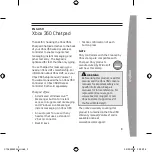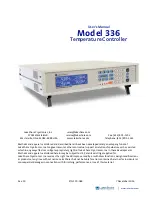
Remote Setpoint Parameters Module (7-n2 or 7-rS) (Optional)
Configuration of the Remote Setpoint involves scaling the input to the
desired setpoint range, selecting f ilter characteristics, and setting
remote/local setpoint transfer response.
Remote Setpoint Display Values (dSP1 and dSP2)
Key-in the display value for Scaling Point 1 and Scaling Point 2.
dSP1 -999 to 9999 (Ex. 0)
dSP2 -999 to 9999 (Ex. 500)
Remote Setpoint Signal Input Values (INP1 and INP2)
The signal input value can either be keyed-in via the front panel buttons or
an input signal can be applied to the appropriate signal input terminals.
Initially, the unit is in the key-in method.
Key-in Method
Key-in the display value for Scaling Point 1 and Scaling Point 2.
INP1 0.00 to 20.00 (Ex. 4.00 mA DC)
INP2 0.00 to 20.00 (Ex. 20.00 mA DC)
Signal Input Method
To change to the apply signal input method, press the D button while InP1
or InP2 is displayed. Front panel annunciators %P and DV flash and the
display indicates the signal value applied to the input terminals. The
controller can be toggled to the key-in method by pressing the D button again.
In this case, the previously accepted value is recalled.
When the desired value is indicated on the display, press the P button to
store the value and advance to the next parameter.
Remote Setpoint Filtering (Fltr and bANd)
The remote setpoint signals can be filtered with a time constraint from 1 to
25 seconds; or the filter can be disabled. The filter is an adaptive, first-order,
low pass type. As long as the difference between the current reading and the
previous reading is less than the filter band value (band), the filter remains in
effect. When the difference exceeds the filter band, the filter disengages until
the difference is less than the filter band value. This action allows quick filter
response to large setpoint changes, while retaining filtering action under
normal process conditions.
Normally the filter band value is set slightly larger than the noise level of
the remote input. The time constant of the filter is set consistent with the
amount of filtering desired. Increased filter time constant values are effective
for smoothing remote setpoint readings. This may be beneficial for cascade
operation and other “live” signal applications.
Alternatively, the remote setpoint can be ramped at a controlled velocity to
limit controller response to large setpoint changes.
Remote/Local Setpoint Transfer Options (trnF)
When switching between Local or Remote Setpoint, the response of the
controller can be programmed in a variety of ways.
These responses apply to changes in setpoint mode from the controller’s
front panel and User Input. The table summarizes the responses for Setpoint
transfer operations:
SPtr Parameter
Local to Remote
Remote to Local
nor
– Output may bump.
Output may bump
Auto
– No output bump. Process
error eliminated at rate of
integral action
No output bump. Process
error eliminated at rate of
integral action
trAC
– Output may bump.
Local setpoint assumes
value of Remote setpoint
(tracks). No Output
bump.
Note: In situations where an output bump may occur, the setpoint ramp function
(SPrP) can be used to reduce or eliminate bumping when switching between
setpoints.
-44-
Содержание CN63100 Series
Страница 23: ...FRONT PANEL PROGRAMMING CHART FOR CN63100 CN63300 CONTROLLERS 15 ...
Страница 48: ... 40 ...
Страница 62: ...PID Adjustments Cont d 54 Figure 33 Process Response Extremes ...
Страница 88: ... 80 ...
Страница 89: ... 81 ...
Страница 90: ... 82 ...
















































